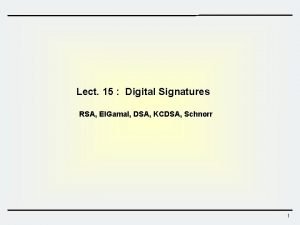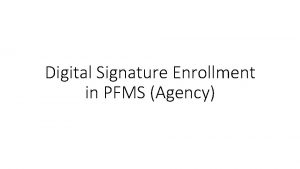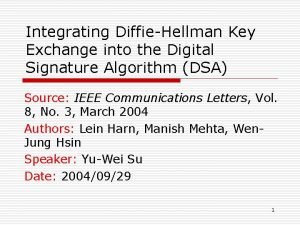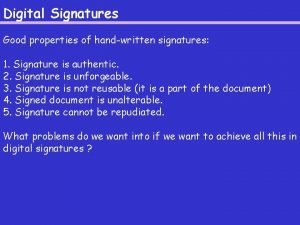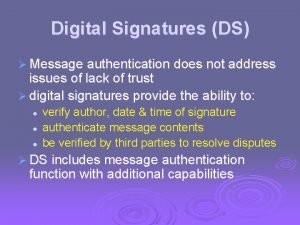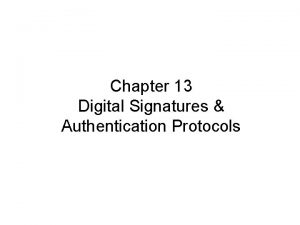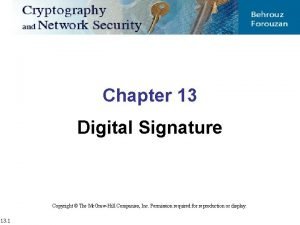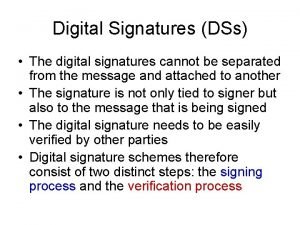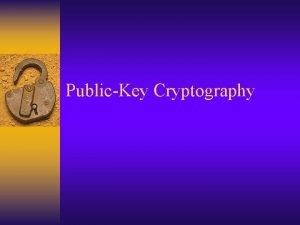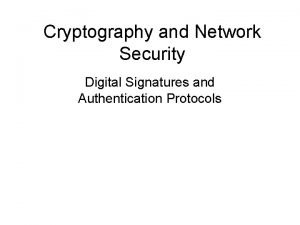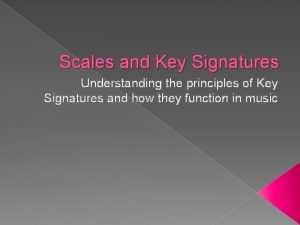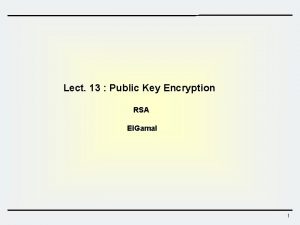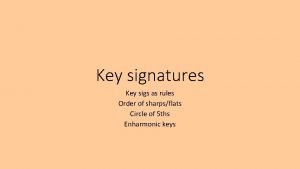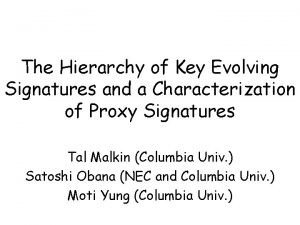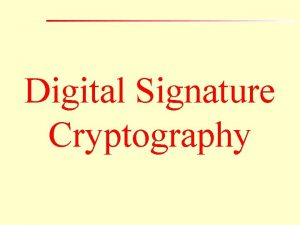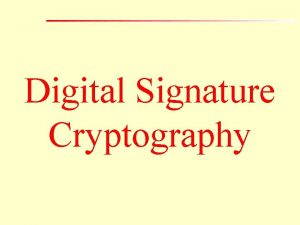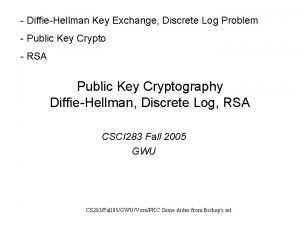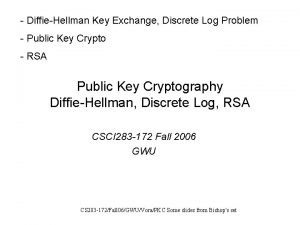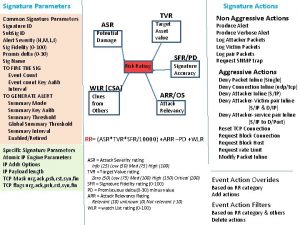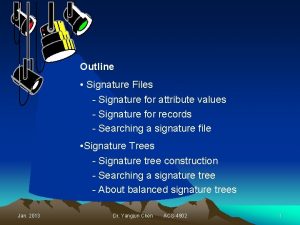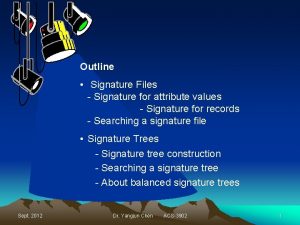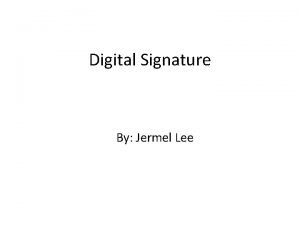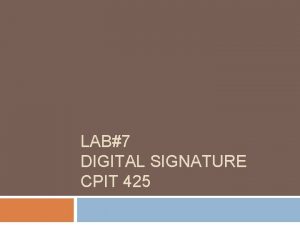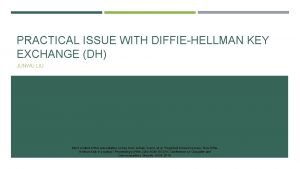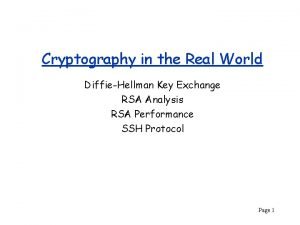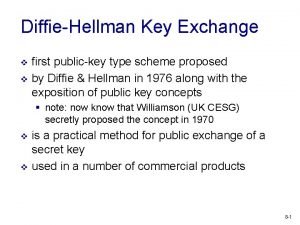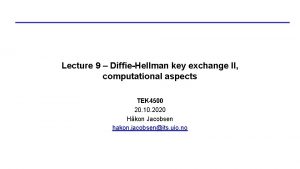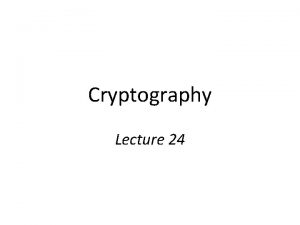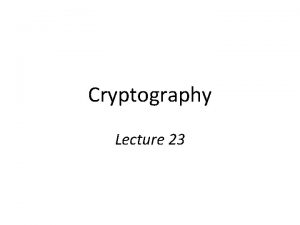Integratining DiffieHellman Key Exchange into the Digital Signature























- Slides: 23

Integratining Diffie-Hellman Key Exchange into the Digital Signature Algorithm (DSA) Source: IEEE Communications Letters, Vol. 8, No. 3, March 2004 Authors: Lein Harn, Manish Mehta, Wen-Jung Hsin Speaker: Yu-Wei Su Date: 1

Outline o 1. Introduction o 2. Concept & Goal o 3. Proposed protocols o 4. Conclusion 2

1. Introduction 1 -1. Key Exchange 1 -2. Diffie-Hellman Algorithm 1 -3. Digital Signature 1 -4. DSA 3

1 -1. Key Exchange ● Symmetric Encryption ● Alice & Bob calculate a session key to communicate Session Key; k EK() Alice DK() Bob 4

1 -2. Diffie-Hellman Algorithm Parameters (1/4) common parameters: g, n: two large primes private parameters: a: random number, choice by Alice b: random number, choice by Bob 5

Operating Flow (2/4) ga mod n gb mod n Alice calculate ((gb mod n)a mod n), result is (gab mod n) Bob calculate ((ga mod n)b mod n), result is (gab mod n) Session key = gab mod n 6

Example n = 11, g = 2 a=4 b=8 (3/4) => ga mod n = 24 mod 11 = 5 gb mod n = 28 mod 11 = 3 Alice : (gb mod n)a mod 11 = 34 mod 11 = 4 Bob: (ga mod n)b mod 11 = 58 mod 11 = 4 Session key = 4 7

The Computational Diffie-Hellman Assumption(CDH assumption) (4/4) ● Eve receives (ga mod n) and (gb mod n) in the channel. ● It is very hard to calculate (gab mod n). 8

1 -3. Digital Signature ● Non-repudiation ● Based on asymmetric scheme message f(message) ps: f() is a digital signature algorithm. 9

1 -4. Digital Signature Algorithm(DSA) 1 -4 -1. Preview o Used in Digital Signature Standard(DSS) o Proposed by NIST o Published in FIPS PUB 186 -x o http: //www. itl. nist. gov/fipspubs 10

Parameters (1/3) Global parameters: p: a prime number, |p| = 512 ~ 1024 (bits), multiple of 64 q: a 160 -bit prime factor of (p-1) h: 1< h < p-1 g = (h(p-1)/q) mod p H(): a hash function, ex: SHA-1 Sender’s Private Parameter: x, random integer with 0 < x < q 11

Parameters (2/3) Sender’s Public Parameter: y = gx mod p m: message Per-Message Secret Parameter: k: random integer with 0 < k < q 12

Signing & Verifying (3/3) Signing (Sender) : r = (gk mod p) mod q s = [k-1(H(m) + xr)] mod q => signature = (r, s) Verifying (Receiver) : w = (s’)-1 mod q u 1 = [H(m’)w] mod q u 2 = (r’)w mod q v = [(gu 1 yu 2) mod p] mod q Test v ? = r’ ps: s’ & r’ are received by receiver which corresponding s & r. 13

2. Concept & Goal 2 -1. DH + DSA Diffie-Hellman Algorithm + Digital Signature Algorithm = Take (ga mod p) as message in DSA 14

2 -2. Three Models 1. One-round protocol 2. Two-round protocol 3. Three-round protocol 15

3. Proposed protocol 3 -1. Parameters User A, B: two users in protocol YA, XA: a key pair, public key & private key of user A in DSA, authenticated. YA = g. XA mod p YB, XB: a key pair, public key & private key of user B in DSA, authenticated. YB = g. XB mod p Other parameters are corresponding in DSA KAB: session key from A to B 16

3 -2. One-round protocol (1/2) Step 1(User A): Select k. A Let m. A = gk. A mod p Let KAB = (YB)k. A mod p (= gx. Bk. A mod p) Calculate r. A = (gk. A mod p) mod q Calculate s. A = [k. A-1(m. A||KAB) + XAr. A] mod q Sent (m. A, s. A) to User B 17

One-round protocol (2/2) Step 2(User B): Receive m. A, s. A from User A Imply r. A = m. A mod q Imply KAB = (m. A)x. B mod p (= gk. Ax. B mod p) Verify (r. A, s. A) of (m. A||KAB) After Step 2, A & B obtain a session key: KAB = gk. Ax. B mod p 18

3 -3. Two-round protocol (1/2) Step 1, Step 2 are the same as one-round protocol. Step 3(User B): (just take B as A) Select k. B Let m. B = gk. B mod p Let KBA = (YA)k. B mod p (= gx. Ak. B mod p) Calculate r. B = (gk. B mod p) mod q Calculate s. B = [k. B-1(m. B||KBA) + XBr. B] mod q Sent (m. B, s. B) to User A 19

Two-round protocol (2/2) Step 4(User A): (just take A as B) Receive m. B, s. B from User B Imply r. B = m. B mod q Imply KBA = (m. B)x. A mod p (= gk. Bx. A mod p) Verify (r. B, s. B) of (m. B||KBA) After Step 4, A & B obtain two session keys: KAB = gk. Ax. B mod p KBA = gk. Bx. A mod p 20

3 -4. Three-round protocol (1/2) Step 1(User A): Select k. A Let m. A = gk. A mod p Sent m. A to User B Step 2(User B): Imply KAB = (m. A)x. B mod p (= gk. Ax. B mod p) Select k. B Let m. B = gk. B mod p Let KBA = (YA)k. B mod p (= gx. Ak. B mod p) Calculate r. B = (gk. B mod p) mod q Calculate s. B = [k. B-1(m. B||KBA||KAB) + XBr. B] mod q Sent (m. B, s. B) to User A 21

Three-round protocol (2/2) Step 3(User A): Let KAB = (YB)k. A mod p (= gx. Bk. A mod p) Imply r. B = m. B mod q Imply KBA = (m. B)x. A mod p (= gk. Bx. A mod p) Verify (r. B, s. B) of (m. B||KBA||KAB) Calculate r. A = (gk. A mod p) mod q Calculate s. A = [k. A-1(H(m. A||KAB||KBA) + x. Ar. A)] mod q Sent s. A to User B Step 4(User B): Imply r. A = m. A mod q Verify (r. A, s. A) of (m. A||KAB||KBA) 22

4. Conclusion o Authentication & Efficient 23
 Message authentication code
Message authentication code Gas exchange key events in gas exchange
Gas exchange key events in gas exchange Dsa
Dsa Dsc enrollment in pfms
Dsc enrollment in pfms Message authentication code example
Message authentication code example Diffie hellman digital signature
Diffie hellman digital signature Properties of digital signature
Properties of digital signature Rsa digital signature
Rsa digital signature Digital signature
Digital signature Digital signature authentication protocol
Digital signature authentication protocol Dsa in network security
Dsa in network security Digital signature authentication protocol
Digital signature authentication protocol Digital signature forgery
Digital signature forgery Dss digital signature
Dss digital signature Attack on digital signature
Attack on digital signature Digital signature algorithm
Digital signature algorithm Cryptography topics crossword
Cryptography topics crossword Unforgeability
Unforgeability Digital signature authentication protocol
Digital signature authentication protocol Do not use key signature
Do not use key signature El gamal algorithm
El gamal algorithm Order of sharps
Order of sharps Key evolving signature
Key evolving signature Real exchange rate vs nominal exchange rate
Real exchange rate vs nominal exchange rate


